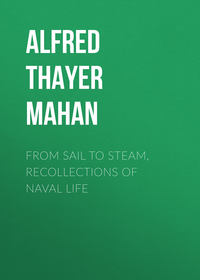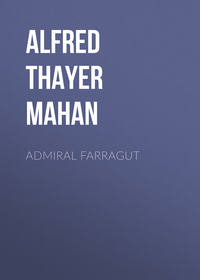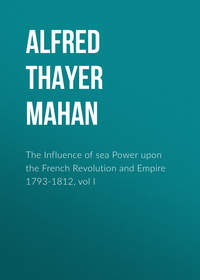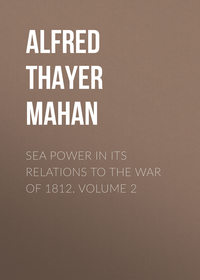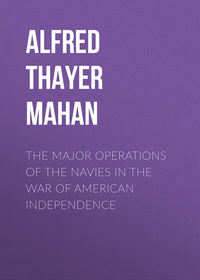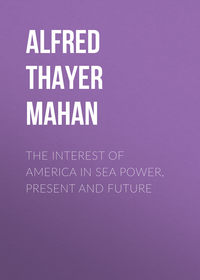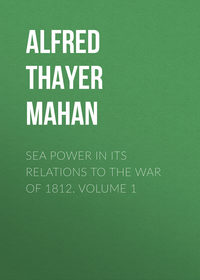 полная версия
полная версияПолная версия
The Life of Nelson, Volume 2
That afternoon they anchored again, about five miles below Copenhagen. Parker and Nelson, accompanied by several senior officers, went at once in a schooner to view the defences of the town. "We soon perceived," wrote Stewart, "that our delay had been of important advantage to the enemy, who had lined the northern edge of the shoals near the Crown batteries, and the front of the harbour and arsenal, with a formidable flotilla. The Trekroner (Three Crowns) Battery"—a strong work established on piles, whose position will be given—"appeared, in particular, to have been strengthened, and all the buoys of the Northern, and of the King's Channels had been removed." Nelson, however, was, or feigned to be, less impressed. "I have just been reconnoitring the Danish line of defence," he wrote to Lady Hamilton. "It looks formidable to those who are children at war, but to my judgment, with ten sail-of-the-line I think I can annihilate them; at all events, I hope to be allowed to try." This is again the same spirit of the seaman "determined to attack" at Aboukir; the same resolution as before Bastia, where he kept shut in his own breast the knowledge of the odds, feeling that to do nothing was as bad as failure—and worse. A like eagerness does not seem to have prevailed on board the flagship. Parker had allowed himself to be stiffened to the fighting-point by the junior he had before disregarded, but that he looked to the issue with more than doubt may be inferred from the words of his private secretary, the Rev. Mr. Scott, who afterwards held the same relation to Nelson. "I fear," he wrote on the day of the council, "there is a great deal of Quixotism in this business; there is no getting any positive information of their strength."

Battle of Copenhagen, Plan Number 1
Nelson's general plan of attack is set forth in main outlines in the letter already given, but it is desirable to give a somewhat more detailed description. It will be seen, by the annexed chart, that there are before Copenhagen two channels by which the city can be passed. Between the two lies a shoal, called the Middle Ground. The inner, known as the King's Channel, lay under the guns of the defences which had been hurriedly improvised for the present emergency. These consisted of a line of hulks, mostly mastless, ranged along the inner side of the King's Channel, close to the flats which bordered it, flanked at the northern end by the permanent work, called the Trekroner29 Battery. Westward of the latter lay, across the mouth of the harbor proper, two more hulks, and a small squadron consisting of two ships-of-the-line and a frigate, masted, and in commission. This division was not seriously engaged, and, as a factor in the battle, may be disregarded.
The northern part of this defence was decisively the stronger. To attack there, Nelson called "taking the bull by the horns." The southern wing was much more exposed. Nor was this all. An advance from the north must be made with a northerly wind. If unsuccessful, or even, in case of success, if ships were badly crippled, they could not return to the north, where the fleet was. On the other hand, attack from the south presupposed a southerly wind, with which, after an action, the engaged ships could rejoin the fleet, if they threaded safely the difficult navigation. In any event there was risk, but none knew better than Nelson that without risks war is not made. To the considerations above given he added that, when south of the city, the British would be interposed between the other Baltic navies and Denmark. The latter, in that case, could not receive reinforcements, unless the English squadron were first defeated. He therefore proposed that ten ships-of-the-line, of the lighter draughts, which he offered himself to lead, should pass through the outer, or northern channel, gain the southern flank of the defence, and thence make the principal attack, while the rest of the fleet supported them by a demonstration against the northern end. The sagacity of this scheme is best attested from the enemy himself. "We have been deceived in the plan of attack," wrote the historian Niebuhr, then residing in the city; "and," now that the right wing of the defence is destroyed, "all is at stake." The nights of the 30th and 31st were employed in surveying the waters, laying down buoys to replace those removed by the Danes, and in further reconnoissance of the enemy's position. The artillery officers who were to supervise the bombardment satisfied themselves that, if the floating defences south of the Trekroner were destroyed, the bomb-vessels could be placed in such a position as to shell the city, without being themselves exposed to undue peril.
Parker gave Nelson twelve ships-of-the-line, two more than he had asked; a judicious addition, for the main part of the fighting was to fall to him, and the difficulties of pilotage might, and actually did, deprive him of several ships. Moreover, while it was proposed that the vessels remaining with Parker should approach and engage the northern defences, yet the time of attack depended upon a fair wind for Nelson; and as that would necessarily be foul for the other body, the diversion made by it might be, and proved to be, ineffective. Sound judgment dictated giving Nelson all that could be spared.
On the afternoon of the 31st another council was held, in which Nelson's plan was finally ratified; he again volunteered his services, which were accepted and his force detailed. As usual, the council was prolific in suggestions of danger. Stewart, who seems to have been present, writes: "During this Council of War, the energy of Lord Nelson's character was remarked: certain difficulties had been started by some of the members, relative to each of the three Powers we should either have to engage, in succession or united, in those seas. The number of the Russians was, in particular, represented as formidable. Lord Nelson kept pacing the cabin, mortified at everything that savoured either of alarm or irresolution. When the above remark was applied to the Swedes, he sharply observed, 'The more numerous the better;' and when to the Russians, he repeatedly said, 'So much the better, I wish they were twice as many, the easier the victory, depend on it.' He alluded, as he afterwards explained in private, to the total want of tactique among the Northern fleets; and to his intention, whenever he should bring either the Swedes or Russians to action, of attacking the head of their line, and confusing their movements as much as possible. He used to say, 'Close with a Frenchman, but out-manoeuvre a Russian.'"
Nelson gave personal supervision to the general work of buoying the Northern Channel. On the morning of April 1st he made a final examination of the ground in the frigate "Amazon," commanded by Captain Riou, who fell in the next day's battle. Returning at about one in the afternoon, he signalled his division to weigh, and, the wind favoring, the whole passed without accident, the "Amazon" leading. By nightfall they were again anchored, south of the Middle Ground, not over two miles from that end of the Danish line. As the anchor dropped, Nelson called out emphatically, "I will fight them the moment I have a fair wind." As there were in all thirty-three ships of war, they were crowded together, and, being within shelling distance of the mortars on Amag Island, might have received much harm; but the Danes were too preoccupied with their yet incomplete defences to note that the few shells thrown dropped among their enemies.
"On board the Elephant," writes Stewart, who with his soldiers had followed Nelson from the "St. George," "the night of the 1st of April was an important one. As soon as the fleet was at anchor, the gallant Nelson sat down to table with a large party of his comrades in arms. He was in the highest spirits, and drank to a leading wind and to the success of the ensuing day. Captains Foley, Hardy, Freemantle, Riou, Inman, Admiral Graves, his Lordship's second in command, and a few others to whom he was particularly attached, were of this interesting party; from which every man separated with feelings of admiration for their great leader, and with anxious impatience to follow him to the approaching battle. The signal to prepare for action had been made early in the evening. All the captains retired to their respective ships, Riou excepted, who with Lord Nelson and Foley arranged the Order of Battle, and those instructions that were to be issued to each ship on the succeeding day. These three officers retired between nine and ten to the after-cabin, and drew up those Orders that have been generally published, and which ought to be referred to as the best proof of the arduous nature of the enterprise in which the fleet was about to be engaged.
"From the previous fatigue of this day, and of the two preceding, Lord Nelson was so much exhausted while dictating his instructions, that it was recommended to him by us all, and, indeed, insisted upon by his old servant, Allen, who assumed much command on these occasions, that he should go to his cot. It was placed on the floor, but from it he still continued to dictate. Captain Hardy returned about eleven. He had rowed as far as the leading ship of the enemy; sounding round her, and using a pole when he was apprehensive of being heard. He reported the practicability of the Channel, and the depth of water up to the ships of the enemy's line. Had we abided by this report, in lieu of confiding in our Masters and Pilots, we should have acted better. The Orders were completed about one o'clock, when half a dozen clerks in the foremost cabin proceeded to transcribe them. Lord Nelson's impatience again showed itself; for instead of sleeping undisturbedly, as he might have done, he was every half hour calling from his cot to these clerks to hasten their work, for that the wind was becoming fair: he was constantly receiving a report of this during the night." It was characteristic of the fortune of the "heaven-born" admiral, that the wind which had been fair the day before to take him south, changed by the hour of battle to fair to take him north; but it is only just to notice also that he himself never trifled with a fair wind, nor with time.
The Orders for Battle, the process of framing which Stewart narrates, have been preserved in full;30 but they require a little study and analysis to detect Nelson's thought, and their tactical merit, which in matters of detail is unique among his works. At the Nile and Trafalgar he contented himself with general plans, to meet cases which he could only foresee in broad outlines; the method of application he reserved to the moment of battle, when again he signified the general direction of the attack, and left the details to his subordinates. Here at Copenhagen he had been able to study the hostile dispositions. Consequently, although he could not mark with precision the situations of the smaller floating batteries, those of the principal blockships were known, and upon that knowledge lie based very particular instructions for the position each ship-of-the-line was to occupy. The smaller British vessels also had specific orders.

Battle of Copenhagen, Plan Number 2
Taking the Trekroner as a point of reference for the Danish order, there were north of it, on the Danish left flank, two blockships. South of it were seven blockships, with a number of miscellaneous floating batteries, which raised that wing of the defence to eighteen—the grand total being therefore twenty. This was also Nelson's count, except that he put one small vessel on the north wing, reducing the southern to seventeen—an immaterial difference. South of the Trekroner, the Danes had disposed their seven blockships—which were mastless ships-of-the-line—as follows. Two were on the right flank, supporting each other, two on the left, the three others spaced between these extremes; the distance from the Trekroner to the southernmost ship being about a mile and a half. The intervals were filled with the floating batteries. It will be recognized that the Danes treated this southern wing as an entity by itself, of which they strengthened the flanks, relying for the protection of the centre upon the nearness to shoal water, which would prevent the line being pierced.
As thus described, the southern wing covered the front of the city against bombardment. The two northern blockships and the Trekroner did not conduce materially to that; they protected chiefly the entrance of the harbor. It was therefore only necessary to reduce the southern wing; but Nelson preferred to engage at once the whole line of vessels and the Trekroner. It is difficult entirely to approve this refusal to concentrate upon a part of the enemy's order,—an advantage to which Nelson was fully alive,—but it was probably due to underestimating the value of the Danish gunnery, knowing as he did how long they had been at peace. He may, also, have hoped something from Parker's division. Be this as it may, he spread his ships-of-the-line, in the arrangement he prescribed, from one end to the other of the enemy's order.
Having done this, however, he adopted measures well calculated to crush the southern flank speedily, and then to accumulate superior numbers on the northern. The British were arranged in a column of attack, and the directions were that the three leading ships should pass along the hostile line, engaging as they went, until the headmost reached the fifth Dane, a blockship inferior to itself, abreast which it was to anchor by the stern, as all the British ships were to do. Numbers two and three were then to pass number one, and anchor successively ahead of her, supporting her there against the other enemy's batteries, while four and five were to anchor astern of her, engaging the two flank blockships, which would have received already the full broadsides of the three leading vessels. Nelson hoped that the two southern Danes, by this concentration of fire upon them, would be speedily silenced; and their immediate antagonists had orders, when that was done, to cut their cables and go north, to reinforce the fight in that quarter. The sooner to attain this end, a frigate and some smaller vessels were told off to take position across the bows of the two blockships, and to keep a raking fire upon them.
The dispositions for the other British vessels were more simple. They were to follow along the outer side of their own engaged ships, each one anchoring as it cleared the headmost ship already in action,—number six ahead of number five, number seven of number six,—so that the twelfth would be abreast the twentieth Dane. One ship-of-the-line was of course thought equivalent to two or three floating batteries, if opposed to them in an interval. By this arrangement, each of the British was covered in its advance, until it reached its prescribed antagonist as nearly fresh as possible, and the order of the British column was reversed from end to end.31 A division of frigates and fireships, under Captain Riou, was held ready for any special service. The bomb-vessels were to anchor in the King's Channel, but well outside the line of battle, from which position they threw some bombs. Alongside each ship-of-the-line was towed a flat-boat, intended to carry soldiers in an attempt to storm the Trekroner, if circumstances favored; and other boats were sent for that purpose from Parker's division.
These orders were copied, and ready for distribution, by six in the morning. Nelson, who was already up and had breakfasted, signalled at seven for all captains, and by eight these had their instructions. The wind had become so fair that ships anchoring by the stern would lie perfectly well for using their broadsides at once. At this instant indecision appeared among the pilots, who were mostly men of only a little local experience, and that gained in vessels much smaller than those they were now to conduct. Nelson, reverting afterwards to these moments, said: "I experienced in the Sound the misery of having the honour of our Country intrusted to pilots, who have no other thought than to keep the ship clear of danger, and their own silly heads clear of shot. At eight in the morning of the 2d of April, not one pilot would take charge of a ship." There is in these words scarcely fair allowance for the men's ignorance. At length one of the Masters of the fleet, a Mr. Brierley, undertook to lead the column, and the signal to weigh in succession was made. The leading ship got off handsomely, but difficulties soon arose. Nelson's old "Agamemnon" was so anchored that she could not weather the Middle Ground; she consequently did not get into action at all. Two other ships, the "Bellona" and "Russell," seventy-fours, grounded on the east side of the Middle Ground, where they remained fast. Although they could use their guns, and did use them against those southern ships which Nelson particularly wanted crushed, the disadvantages of distance, of position, and of general helplessness, detracted exceedingly from their usefulness. The valid British force was thus reduced by one-fourth,—to nine vessels.
Nelson's ship, the "Elephant," was following the "Bellona" and "Russell," and he saw them ground. "His agitation during these moments was extreme," says an eye-witness. "I shall never forget the impression it made on me. It was not, however, the agitation of indecision, but of ardent, animated patriotism panting for glory, which had appeared within his reach, and was vanishing from his grasp." He doubtless well knew the thinly veiled reproaches of rashness, cast by timid counsels upon the daring, which even under these disadvantages was to cover with confusion their prophecies of disaster; but, as on many another day, and in that more famous incident, a few hours later, in this same battle, his tenacious purpose harbored no side-thought of retreat. "Before you receive this," he had written to Lady Hamilton, "all will be over with Denmark,—either your Nelson will be safe, and Sir Hyde Parker a victor, or he, your own Nelson, will be laid low." The signal to advance was kept flying, but new dispositions had to be made to meet the new and adverse conditions.32 The remaining ships were made to close to the rear, as they anchored. The "Elephant" had been originally assigned as antagonist to the biggest Danish ship, the "Sjaelland," seventy-four; but, the "Bellona" having grounded, she now dropped into the latter's berth immediately ahead of the "Glatton;" and Nelson hailed the "Ganges," as she was passing, to place herself as close as possible ahead of the "Elephant." This movement was imitated by the "Monarch," which thus got the "Elephant's" position abreast the "Sjaelland." Here, according to Danish accounts, the contest stood for some time, until the "Defiance," Graves's flagship, arriving, anchored ahead of the "Monarch," completing the line of nine British ships. Captain Riou with his light division engaged the Trekroner, and the Danish blockship next south of it, which was by him terribly battered. From this moment, and for some time, to use subsequent words of Nelson, "Here was no manoeuvring: it was downright fighting."
Meanwhile Parker's division, which had weighed as agreed, was some four miles off, beating up against Nelson's fair wind. It had not yet come into action, and the anxious chief, ever doubtful of the result of a step into which he had been persuaded, contrary, not, perhaps, to his will, but certainly to his bent, watched the indecisive progress of the strife with a mind unoccupied by any fighting of his own. Two things were evident: that Nelson had met with some mishaps, and that the Danish resistance was more prolonged and sturdier than he had argued in the Council that it would be. Parker began to talk about making the signal to leave off action, and the matter was discussed between himself, his fleet-captain, and Otway, the captain of the ship. The latter opposed the idea strongly, and at last, as a stay, obtained the admiral's authority to go on board the "Elephant" and learn how things were. He shoved off accordingly, but before he reached Nelson the signal was made.

Vice Admiral, Sir Hyde Parker
Nelson at the moment was walking the quarter-deck of the "Elephant," which was anchored on the bow of the Danish flagship "Dannebroge," engaging her and some floating batteries ahead of her. At this time, Stewart says, "Few, if any, of the enemy's heavy ships and praams had ceased to fire;" and, after mentioning various disappointments that had befallen the smaller British vessels, besides the failure of three heavy ships to reach their stations, he continues: "The contest, in general, although from the relaxed state of the enemy's fire, it might not have given much room for apprehension as to the result, had certainly not declared itself in favour of either side. Nelson was sometimes much animated, and at others heroically fine in his observations. A shot through the mainmast knocked a few splinters about us. He observed to me, with a smile, 'It is warm work, and this day may be the last to any of us at a moment;' and then, stopping short at the gangway, he used an expression never to be erased from my memory, and said with emotion, 'but mark you, I would not be elsewhere for thousands.'
"When the signal, No. 39, was made, the Signal Lieutenant reported it to him. He continued his walk, and did not appear to take notice of it. The lieutenant meeting his Lordship at the next turn asked, 'whether he should repeat it?' Lord Nelson answered, 'No, acknowledge it.'33 On the officer returning to the poop, his Lordship called after him, 'Is No. 16 [For Close Action] still hoisted?' The lieutenant answering in the affirmative, Lord Nelson said, 'Mind you keep it so.' He now walked the deck considerably agitated, which was always known by his moving the stump of his right arm. After a turn or two, he said to me, in a quick manner, 'Do you know what's shown on board the Commander-in-Chief, No. 39?' On asking him what that meant, he answered, 'Why, to leave off action.' 'Leave off action!' he repeated, and then added, with a shrug, 'Now damn me if I do.' He also observed, I believe, to Captain Foley, 'You know, Foley, I have only one eye—I have a right to be blind sometimes;' and then with an archness peculiar to his character, putting the glass to his blind eye, he exclaimed, 'I really do not see the signal.' This remarkable signal was, therefore, only acknowledged on board the Elephant, not repeated. Admiral Graves did the latter, not being able to distinguish the Elephant's conduct: either by a fortunate accident, or intentionally, No. 16 was not displaced.
"The squadron of frigates obeyed the signal, and hauled off. That brave officer, Captain Riou, was killed by a raking shot, when the Amazon showed her stern to the Trekroner. He was sitting on a gun, was encouraging his men, and had been wounded in the head by a splinter. He had expressed himself grieved at being thus obliged to retreat, and nobly observed, 'What will Nelson think of us?' His clerk was killed by his side; and by another shot, several of the marines, while hauling on the main-brace, shared the same fate. Riou then exclaimed, 'Come then, my boys, let us all die together!' The words were scarcely uttered, when the fatal shot severed him in two. Thus, and in an instant, was the British service deprived of one of its greatest ornaments, and society of a character of singular worth, resembling the heroes of romance." Fortunately for the British, not a ship-of-the-line budged. Graves had indeed transmitted the order by repeating it, but as he kept that for close action also flying, and did not move himself, the line remained entire throughout a period when the departure of a single ship would have ruined all, and probably caused its own destruction.
This incident of refusing to see the signal has become as hackneyed as a popular ballad, and in its superficial aspect, showing Nelson as the mere fighting man, who, like a plucky dog, could not be dragged off his antagonist, might well now have been dismissed with the shortest and most summary mention. Of late years doubt has been cast over the reality of Nelson's disobedience, for the reason that Otway, whose mission has already been noted, carried a verbal message that the order was to be understood as permissive, leaving Nelson the liberty to obey or not. From Otway's biography, however, it appears that the signal was hoisted before he reached the "Elephant." Parker's Secretary, Mr. Scott, has also stated distinctly, that "it was arranged between the admirals, that, should it appear the ships which were engaged were suffering too severely, the signal for retreat would be made, to give Lord Nelson the option of retiring, if he thought fit."34




